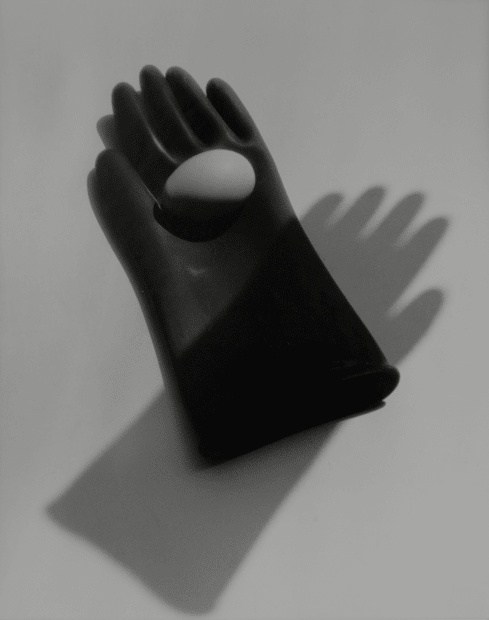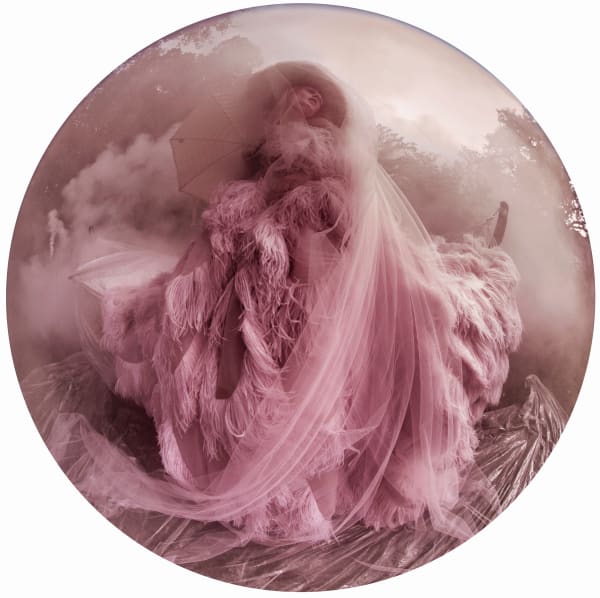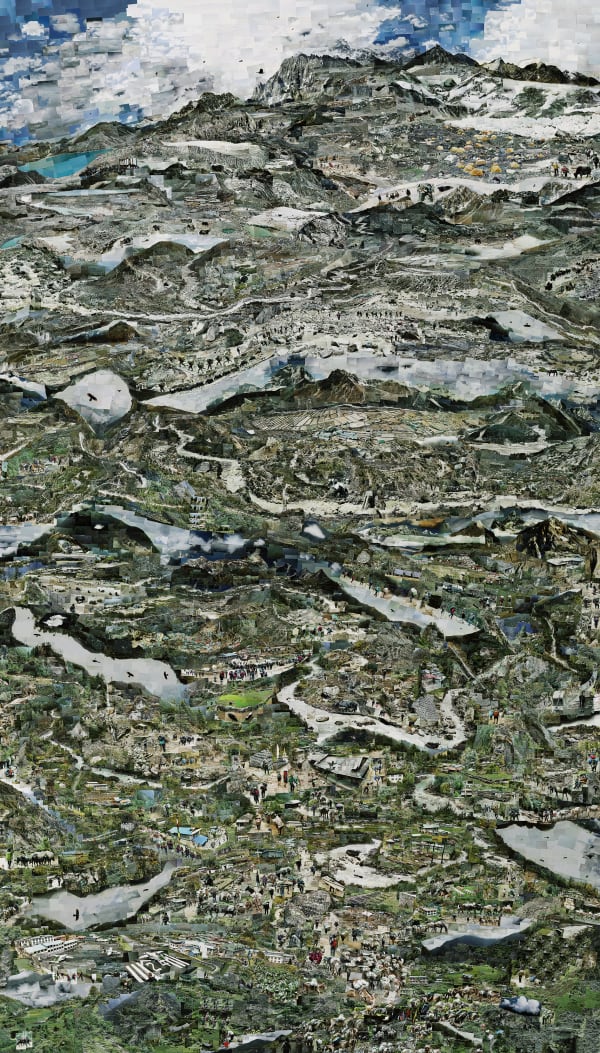Paris Photo New York highlights
Dear Friends,
This week we present you with our fourth Viewing Room, to close the month of April and round up our Paris Photo New York offering.
I hope you enjoy my personal selection of highlights, which include individual works that resonate with me by Japanese photographers Katsuji Fukuda, Sohei Nishino and Iwao Yamawaki.
Also featured are pieces by Eamonn Doyle and Tim Walker as we take you through the story of each work and the artists' influences; from material as diverse as the maps traditionally used by pilgrims to navigate holy sites to 19th century concave mirrors.
As always I look forward to receiving your comments, queries and questions.
Best wishes,
Michael Hoppen
-
-

-
Fukuda returned to the graphically contrasting image of the egg against gloves throughout his career. This motif appears for the first time in 'Photo Publicity', a photobook from 1933 in which Fukuda's work was selected as part of a group show organised by Asahi Newspapers in Tokyo.


Progression of the glove and egg from commercial to signature (Heiting / Kaneko, Steidl 2017)
Fukuda's work was included alongside photography by Kimura Ihei, Ueda Shoji and Nakayama Iwata, and the book was translated into French so that international audiences might learn about developments in contemporary Japanese photography. In 1938, Fukuda returned to this image in a very different context, showing the glove and egg in a softer grey palette, and with a heightened sense of perspective and field depth. By this time, Fukuda was already gaining recognition for his technical acumen and skill as a commercial photographer, and in his book 'Practical Photography: My Photo Book', he illustrates some of his most successful approaches to documenting subjects he encountered during his everyday life. His decision to use an outline of the glove alongside his name in the frontispiece implies that it had become something of a personal signature.'
Signed, titled in pencil, date and various print date stamps on versoVintage silver gelatin. Exhibition print.41 x 33.3 cm£7,500 excluding tax and shipping -
-

-
-

-
-

-
This photograph takes inspiration from a 19th century circular concave mirror originally belonging to renowned early photographers David Octavius Hill and Robert Adamson (see installation shot). Hill and Adamson formed Scotland's first photographic studio and for early photographers like them, natural daylight was crucial to creating the perfect portrait: this mirror would have been used to reflect sunlight onto the faces of their sitters. Tim Walker's James Crewe, Fashion: Valentino Haute Couture, Dorset, 2018, shot with fish-eye lenses, framed in a circular frame with a domed glass, is presented in the museum as the matching half of the mirror, one almost feels that the photograph was born from it.
Tim was especially drawn to the moon-like shape of the mirror. The moon has always been a source of inspiration for him, as cited in the title of his recently released retrospective book, Shoot for the Moon. The phrase originated from a quote by American author Norman Vincent Peale: 'Shoot for the moon. Even if you miss, you will land among the stars.' This is a message that Tim Walker wants to share with all of us, as creatives around the world.

Installation shot : "Wonderful Things", Victoria and Albert Museum London, September 2019
Tim Walker
Born in England in 1970, Tim Walker's interest in photographs began at the Condé Nast library in London where he worked on the Cecil Beaton archive before taking up a place at Exeter College of Art to study photography. After graduating, he became assistant to Richard Avedon in New York before returning to England where he initially concentrated on portrait and documentary work for UK newspapers.
At the age of 25 Walker shot his first fashion story for Vogue, and has photographed for the British, Italian and American editions ever since. He has also contributed to Harpers Bazaar, W, i-D and Vanity Fair magazines, and advertising campaigns for brands such as Yohji Yamamoto, Guerlain and Dior Parfums.
His first major show was held at the Design Museum in London in 2008, coinciding with the publication of his first monograph Pictures. In November 2008 Walker received the Isabella Blow Award for Fashion Creators from The British Fashion Council and, in May 2009, he received an Infinity Award from The International Center of Photography, New York. In 2012 Tim opened a major mid-career retrospective at Somerset House in London which marked the launch of his second book Story Teller (Thames and Hudson, 2012). In 2019, he was the subject of a major solo exhibition at the Victoria and Albert Museum, the largest show the museum has ever held for a living artist. Walker's work is held in the permanent collections of both the Victoria and Albert Museum and the National Portrait Gallery in London.
Accompanied by a signed, titled and editioned artist labelArchival pigment printEdition of 10100 cm diameter (round image)£20,000 excluding frame, tax and shipping -
-
-
Sohei Nishino
In making his diorama maps, Nishino combines photography, collage, cartography and psychogeography to create large prints of diverse places. Drawing inspiration from the 18th century Japanese mapmaker Ino Tadataka, his prints re-imagine the locations he has visited. To build his diorama maps, Nishino walks for an average of three months, exploring many vantage points and gathering hundreds of rolls of exposed film. He then painstakingly prints the photographs by hand and compiles them to form the tableaux he will use as the basis for his limited edition photographs.
The overall effect is not a traditional bird's-eye view but an enlightened way of seeing three dimensions in a single plane. Although geographical accuracy is important in this process, scales are altered and locations occasionally repeated, mimicking our own fluid memories of place and time. From a distance the maps are almost abstract, it is not until we examine them in detail that the full diorama unfolds - the theatre of one man's city played out in miniature.
Sohei Nishino was born in Hyogo, Japan in 1982. He graduated from Osaka University of the Arts in 2004, when he began working on his diorama Map series. Since then he has exhibited his work internationally and gleaned numerous awards including the President Award, Osaka University of Arts (2004), the Young Eye Japanese Photographer Association Award (2005), the Canon New Cosmos Photography Award (2005) and the Canon Excellence Award (2005). He has also participated in several group shows, festivals and solo exhibitions: Daegu Photo Biennale, Korea (2010); Out of Focus exhibition, Saatchi Gallery, London (2012); Contemporary Japanese Photography vol.10, Tokyo Metropolitan Museum of Photography (2012); A Different Kind of Order: ICP Triennial, New York (2013).
Sohei Nishino "Mountain Lines, Everest", 2019
Accompanied by a signed, titled and editioned artist label
Pigment print on Hahnemuhle Photo-Rag Baryta paper
Edition of 15
185 cm x 105.4 cm
£25,000 excluding tax and shipping, including framing
ENQUIRE -
Click on any given image for more details
-
 Katsuji Fukuda, Still Life, 1954-55
Katsuji Fukuda, Still Life, 1954-55 -
 Iwao Yamawaki, Men Working on Banner, Moscow 1931
Iwao Yamawaki, Men Working on Banner, Moscow 1931 -
 Eamonn Doyle, O'Connell street, Dublin, 2017
Eamonn Doyle, O'Connell street, Dublin, 2017 -
 Tim Walker, James Crewe, Fashion: Valentino Haute Couture, Dorset, 2018
Tim Walker, James Crewe, Fashion: Valentino Haute Couture, Dorset, 2018 -
 Sohei Nishino, Mountain Lines, Everest , 2019
Sohei Nishino, Mountain Lines, Everest , 2019 -
 Tim Walker, Claire Foy, Smoking Queen, Fashion: Alexander McQueen. London, 2017
Tim Walker, Claire Foy, Smoking Queen, Fashion: Alexander McQueen. London, 2017
-
-
WE HOPE THAT YOU HAVE ENJOYED OUR VIRTUAL OFFER AND THAT YOU WILL REACH OUT
TO US IF YOU HAVE QUESTIONS OR WOULD LIKE TO KNOW MORE.CLICK HERE TO VIEW OUR FULL OFFERING
PARIS PHOTO NEW YORK - FULL VIRTUAL TOUR










